Malassezia Dermatitis + Otitis: Yeast Infections in Dogs
Remember, this is an educational resource, not a guide for diagnosis.
Pictures are helpful, but they may not tell the whole dermatological story. We always recommend consulting with your vet for any of your dog's health concerns.
🎄 25% Off 🎄 Christmas Countdown Sale
Use code FELIZNAUGHTYDOG at checkout and get your dog, grand-dog, or your friend's dog the gift of relief!

What is Malassezia and Yeast?
Yeasts are a type of fungus - singe-celled microscopic organisms that are naturally present in the environment and our digestive systems. They are beneficial in many ways, and were one of the first "domesticated" microorganisms - used in everything from bread and beer to drugs and dietary supplements.
Malassezia pachydermatis is a form of yeast that dwells on canine skin; its cells have a round or peanut shape when seen under the microscope. Much like bacteria, yeast isn't harmful until an abnormal overgrowth occurs.
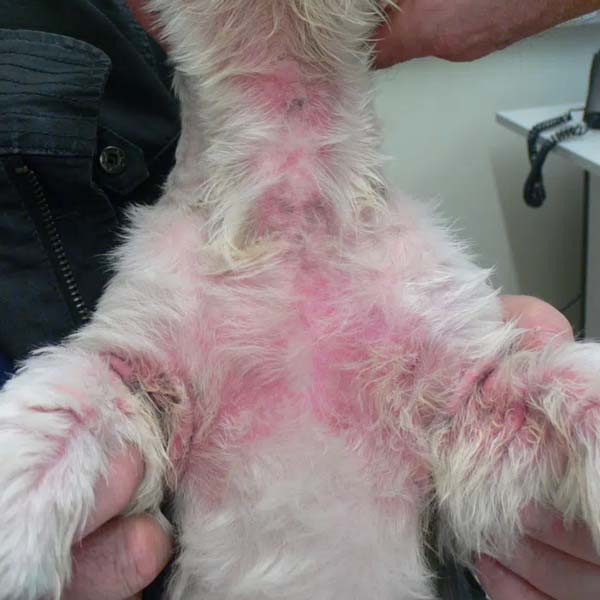
What Causes Yeast Infections and Dermatitis in Dogs?
Canine yeast infections and dermatitis are very common skin problems that are caused by the unchecked growth of Malassezia yeast. They can happen to any dog, but certain breeds are more prone to yeast infections than others.
Yeast infections tends to develop as a result of a change in the dog's skin condition, their immune system, or their environment. Some common causes include allergens and irritants (mold, dust, chemicals, etc), parasitic bites, certain food allergies, heat and humidity, and trapped moisture in areas with no airflow (i.e., ears and skin folds).
Yeast dermatitis in dogs can also arise as a secondary problem due to bacterial infection (aka pyoderma). Malassezia is believed to have a symbiotic relationship to the bacteria Staphylococcus pseudintermedius, which causes the majority of bacterial skin infections in dogs. Yeast cells can find haven when Staphylococcus creates a bacterial biofilm - a type of barrier that protects the microbes from antibiotics, cleaning solutions, and other threats.
Photo: Yeast infection on dog's neck and chest, via Willows Veterinary Centre & Referral Service
Are There Foods That Cause Yeast Skin Infections in Dogs?
Certain proteins are often the food ingredients that cause allergic reactions, and chicken is the most frequent food allergen found to be correlated with yeast infections. A diet that is high in sugar and carbohydrates is also believed to be a contributing factor of yeast dermatitis and ear infections (otitis).
Determining your dog's skin and food sensitivities can be a tricky trial-and-error process, but if your dog suffers from chronic skin issues, it could potentially make all the difference in their overall health. It is best to consult with your veterinarian, as they can offer the proper guidance and trials to map out your dog's allergens.
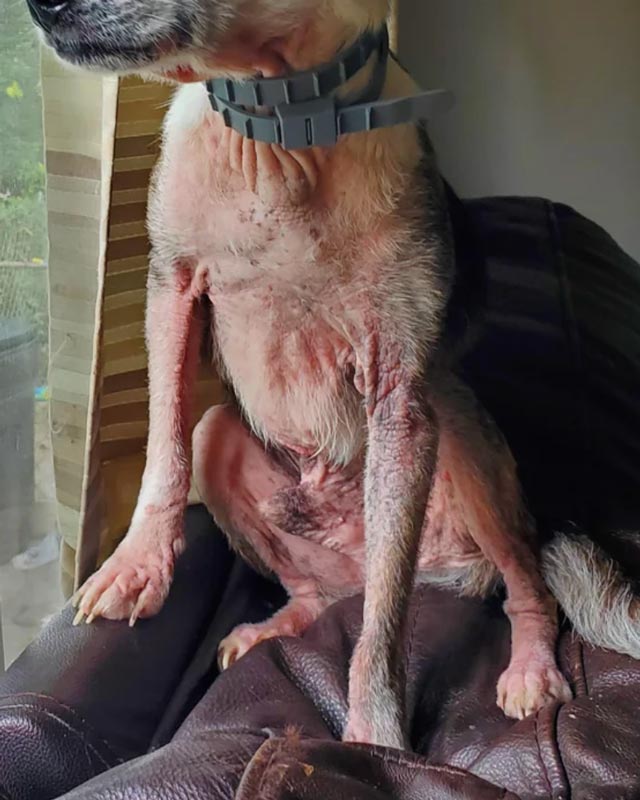
Symptoms of Canine Yeast Infections
Yeast Otitis (Ear Infection)
- Repetitively scratching ears and shaking head (ear infection)
- Inflamed ear canals
- Brown ear discharge with bad odor
Yeast Dermatitis
- Severe itching (pruritis)
- Areas of red or pink skin
- Hair loss (alopecia)
- Scaly, greasy, skin crusts (referred to as seborrhea) of yellow or gray color
- Strong musty odor
- Crusts, pimples, or pustules
- Inflammation, especially between skin folds (intertrigo), armpits, and groin
- Patches of hyperpigmentation (darkened skin) and hardened, leathery skin (lichenification)
Paw Yeast Infection
- Excessive paw licking, biting, and chewing
- Discoloration of the skin
- Hair loss
- General redness or "pinkness" between pads
- Inflammation and/or infection of nails, with discoloration
Photo: Senior chihuahua mix with Malassezia yeast infection, via r/Distinct-Forever642 on Reddit
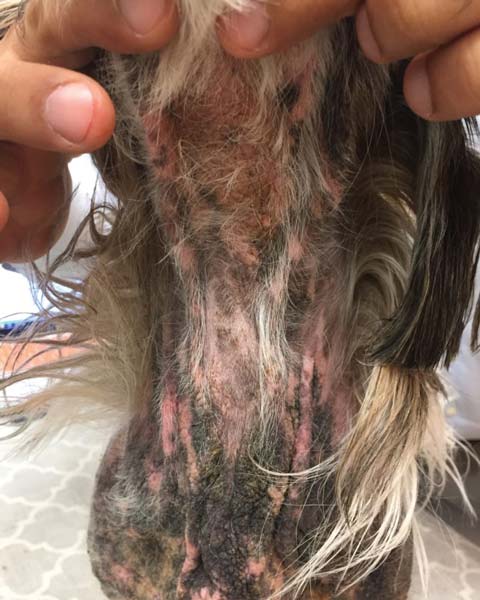
Types of Yeast Infections in Dogs
Skin (Dermatitis)
Yeast dermatitis refers to a yeast infection of the skin. While it can spread across the body, yeast dermatitis tends to affect areas such as lip margins, skin folds, armpits, groin, vulva, and neck. It tends to go hand-in-hand with skin fold dermatitis (intertigo).
Yeast dermatitis is not contagious and cannot be spread to other dogs. It is typically caused by an increase in the natural oils produced on the skin due to allergies or a condition called seborrhea oleosa.
Dogs with deficient immune systems may contract chronic infections, as their bodies cannot effectively fight off the yeast cells. Though uncommon, some dogs can develop an allergic reaction to yeast and experience an extreme inflammatory reaction with even a small amount of yeast on the skin.
Photo: Yeast dermatitis with darkened skin on neck and chest of dog, by Jangi Bajwa, DVM; via the Canadian Veterinary Journal.
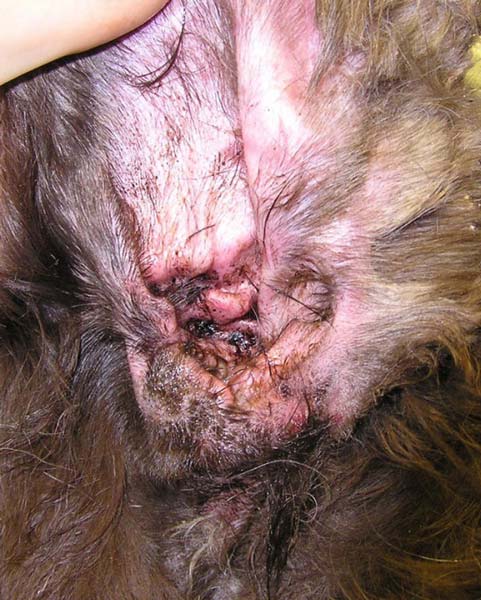
Ear (Otitis)
Yeast infections of a dog's ear (yeast otitis) cause a thick, odorous discharge and a whole lot of itching. They can occur in the external (otitis externa) or middle (otitis media) part of the ear, and dogs will scratch their ears and shake or tilt their heads for relief.
Yeast ear infections commonly develop in relation to environmental or food allergies, irritants or debris in the ear, thick hair in the ear, or in relation to other health issues such as hypothyroidism, diabetes, or an autoimmune disorder.
Breeds with long ears, such as spaniels, basset hounds, and labradors are more prone to ear infections. Dogs that spend a lot of time in water - allowing for moisture to get trapped in the ear - are also more liable to contract a yeast ear infection.
Photo: Canine ear with yeast infection with brown discharge; via the Cornerstone Animal Clinic of Dallas.
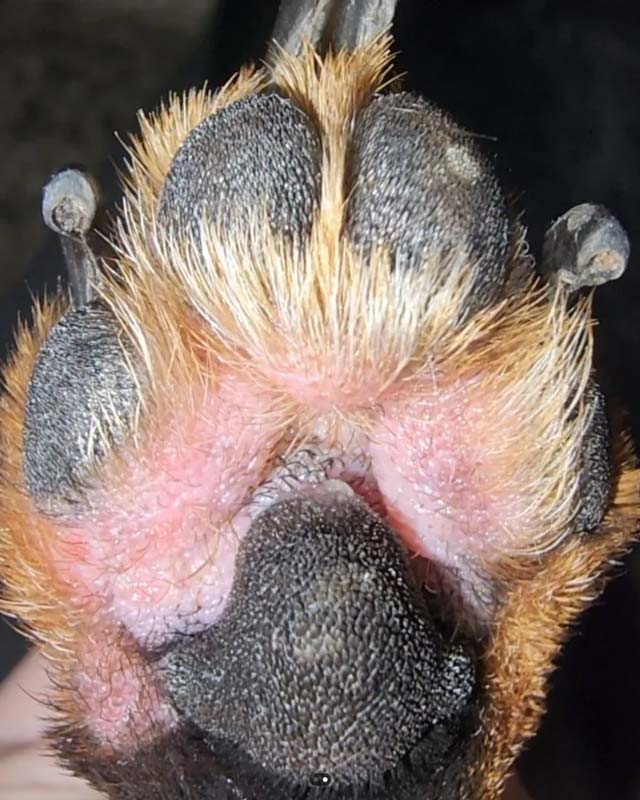
Paws
Dog paw yeast infections are extremely common and tend to occur in relation to environmental skin allergies, like from dust, pollen, or grass. Dogs will constantly lick and chew their paws, which can bring about redness, open sores, and further infection.
The damp, covered area between toes and paw pads and the region near the nail beds are especially susceptible. It shouldn't be forgotten that dogs perspire through their feet, so all-in-all their paws make for an excellent Petri dish for yeast and bacteria to grow.
Ever heard of "Frito feet?" It's the natural presence of these yeast and microbes that give dogs' paws that lovely corn chip odor. On top of that, dog paws absorb contact almost constantly, so it's only a matter of time before the skin becomes damaged and the yeast that naturally dwells nearby can take over.
It's good to check your dogs paws regularly - especially if they're licking them more than normal - to make sure there isn't a hidden problem that's becoming worse. For the curious, check out these top reasons for excessive canine paw licking for more insight into this habit.
Photo: Yeast dermatitis with inflammation between paw pads, via r/IndependentPublic9 on Reddit
Breeds Commonly Affected by Yeast Dermatitis
How Do You Test for Canine Yeast Infections?
Since yeast infections and dermatitis can be secondary issues, collecting samples is necessary to ascertain that there aren't compounding problems, such as bacterial infection. There are several sampling techniques to identify and diagnose yeast infections.
- Cotton swab: A sterile swab is used to gather cells from the area. From there it can be transferred to a microscope slide, stained (so the cells can be easily seen), and examined, or sent as a culture to a lab for identification.
- Acetate tape impression: A piece of clear tape is applied to the skin
- Microscope slide impression smear: This saves a cotton swab or tape and simply presses the slide directly onto the area.
- Skin scrape: A dull blade is used to scratch the skin and collect yeast organisms.
- Skin biopsy: This technique uses a punch to collect a deeper skin sample. It is the most invasive form of testing, but it yields the most data. Skin biopsies may be administered when the yeast infections are chronic or unresponsive to treatment.
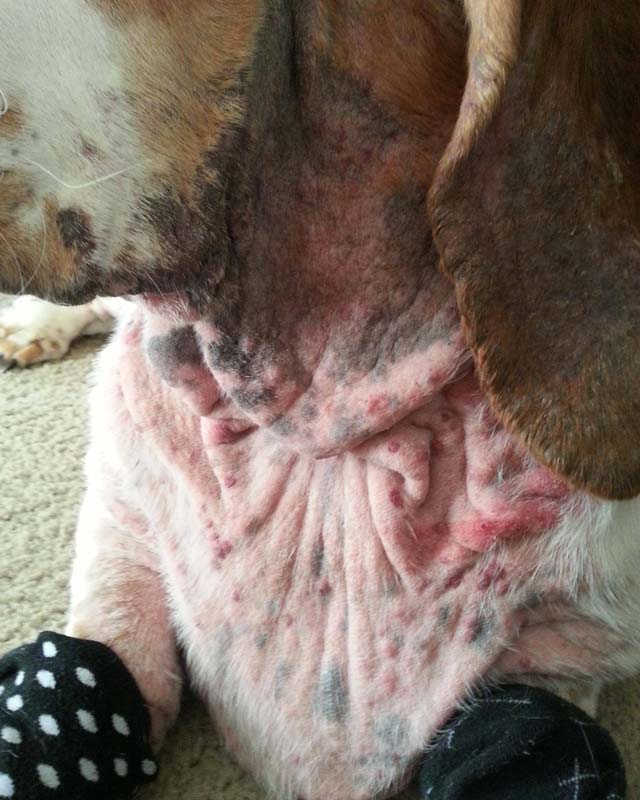
How Are Canine Yeast Infections Treated?
Medicated shampoos with selenium sulfide or benzoyl peroxide are typically used initially to "degrease" and cleanse the skin affected by a yeast infection. From there, bathing with anti-fungal shampoo with chlorhexidine, ketaconazole, or miconazole every 3-5 days for several weeks may be needed.
For localized dermatitis spots or a paw yeast infection, an antifungal ointment may be prescribed. For yeast otitis (ear infection), a medicated ear wash and topical steroid my be recommended to reduce inflammation. Alternatively, Lavengel® may be able to help with paw and ear yeast infections, with no prescription necessary.
For severe cases of yeast infections, systemic oral anti-fungal medications such as ketoconazole, terbinafine, or fluconazole may be required. Dogs with yeast dermatitis will likely have a bacterial (pyoderma) skin infection, so antibiotics may be needed on top of the antifungals to clear the compound infection.
While these medications are effective, they call for prolonged use to eradicate the infection(s). This can put stress on the liver and have potentially harmful side effects.
Photo: Yeast infection on neck, ears, and chest of basset hound, via r/npbrunco on Reddit
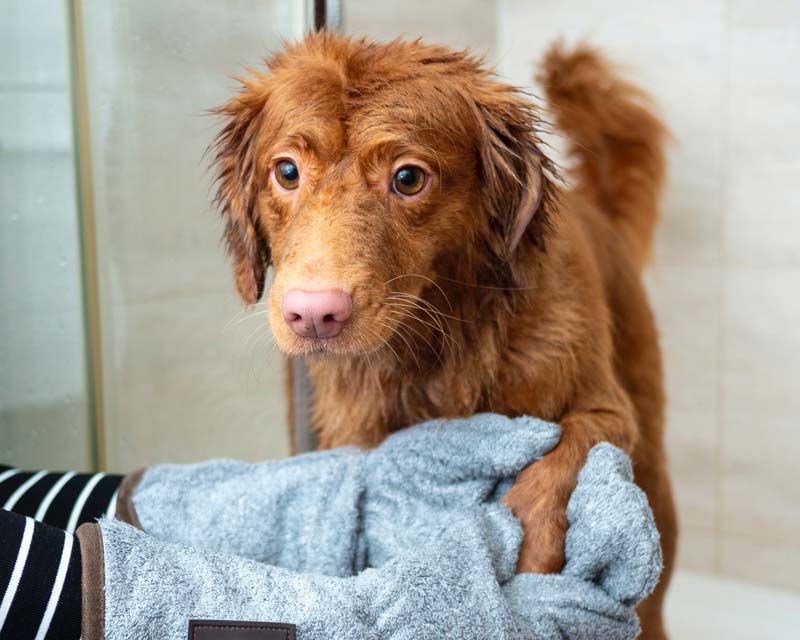
What Home Remedies Can Help Prevent a Dog Yeast Infection?
We always recommend seeking veterinary attention if your dog has a yeast infection, especially since there may also be a bacterial infection or complications present.
A few ways you can help prevent your dog from developing a yeast infection are:
- Regular bathing, with attention to "sheltered" areas, such as between skin folds, under armpits, between toes and pads, etc.
- Making sure your dog is completely dry after a bath or being in water.
- Regular ear cleaning with a clean cloth, cotton ball, or ear wipes
- For dogs with longer inner ear hair, consider having it trimmed
- Regular brushing/grooming to clear loose hair, dirt, and dead skin
- Feeding them a healthy, well-balanced diet
- Being aware of your dog's seasonal, environmental, and food allergies
- Keep them indoors during extreme heat and humidity
- Routine vet visits and staying up to date on vaccinations
Yeast in Dogs FAQs
Are dog yeast infections contagious?
No, canine yeast infections are not contagious to other dogs or humans.
Yeast infections, especially yeast dermatitis, tend to arise due to an underlying skin allergy or other skin problem, such as seborrhea, which causes an excessive amount of oil on the skin that yeast feed on.
That said, while the yeast infection itself is not contagious, an underlying condition that brought about the yeast infection - or has come along in tandem with it - could be contagious.
Can a dog's yeast infection go away on its own?
While there is a slight chance for a dog's immune system to counter a yeast infection, it is far more likely that the infection will continue to spread. It is also more likely that a secondary infection - either bacterial or fungal - will set in as your dog scratches at the itch.
Bottom line: It's far better to seek professional treatment for a canine yeast infection than to let it (hopefully) go away on its own. The earlier you can catch and counter the infection, the more likely it will be eliminated sooner.
Is there a vaccination for yeast infections in dogs?
At this time there is no vaccine to prevent or cure a canine yeast infection.
Can Lavengel® help with yeast dermatitis?
Yes, Lavengel® can be helpful with spot treatments on yeast dermatitis, such as on paws, between pads, in ears, and isolated patches on the skin.
That said, for infections that have spread and become more generalized, we highly recommend consulting with your vet for further steps.
How long does it take for a dog's yeast infection to go away with treatment?
The length of time to eliminate a yeast infection in your dog can take anywhere from a few weeks to several months, depending heavily on several factors:
- Location, severity, and spread of the infection
- How early the infection is accurately diagnosed
- How quickly treatment is started and diligently its regimen is followed
- If there is a secondary infection (bacterial pyoderma or other fungal), which can require additional medications or therapies
- If your dog has any underlying allergies
- If your dog has a history of contracting yeast infections
- If your dog has an underlying autoimmune or hormonal disease, such as hypothyroidism, Cushing's disease, or diabetes
What's the difference between a yeast skin infection and mange?
Yeast infections are caused by a fungus (Malassezia pachydermatitis), and mange is caused by two types of parasitic mites, with each causing a different form. Yeast and mange require very different forms of treatment. You can get a lot more info on the two types of mange on our Mange Resource page.
Since both types of conditions - in their severe forms - can result in hair loss, severe itching, hyperpigmentation (dark coloring), and scaly skin, these two conditions are often confused. In fact, a severe mange mite infestation can lead to secondary pyoderma and yeast infections.
It should be noted that, in general, mange is rather uncommon, and occurs much less frequently than yeast dermatitis.
What's the difference between a yeast skin infection and ringworm?
Though they are both fungi, yeast infections are caused by Malassezia pachydermatis, and ringworm (dermatophytosis) is caused by one of three species of fungus:
- Microsporum canis (about 70% of cases in dogs)
- Microsporum gypseum (about 20%)
- Trichophyton metagrophytes (about 10%)
Both fungi can feed on dead cells and hair follicles and spread quickly, creating hairless patches.
Unlike yeast dermatitis, ringworm is extremely contagious, even across species, and its spores can live on abiotic surfaces for months.
Each fungal infection is diagnosed differently, though both may be treated using anti-fungals with similar ingredients. The big difference in treating ringworm is that the dog must be quarantined, and all bedding, clothing, harnesses, and articles that they come into contact with must be sterilized or discarded.
See our Ringworm Resource page for much more info.
Can certain foods cause yeast infections in dogs?
Foods themselves don't necessarily "cause" yeast infections, but they may bring about an allergic reaction that makes a dog more likely to contract a yeast infection.
In dogs, yeast infections of the ear (yeast otitis) are most commonly linked with food allergies - though it certainly does not account for all cases.
In general, the most common foods that canine allergies are linked to are:
- Chicken
- Beef
- Dairy
- Wheat
- Soy
- Eggs
In addition, feeding your dog foods that are high in sugar and carbs can be conducive to yeast growth.
That said, canine food allergies are understood to be less prevalent in dogs compared to seasonal or environmental allergies.
If you're feeling studious, learn (way) more in our Complete Guide to Food Allergies in Dogs.
Unless you are aware of a food sensitivity in your dog, it is more likely that a seasonal/environmental allergy, change in temperature or humidity, or another aggravating factor (e.g., bee stings, flea bites, bacterial infection in cut or scrape, lack of bathing, etc.) has distressed the skin and brought about the yeast infection.
Does a corn chip smell mean my dog has a paw yeast infection?
As we mention in our Dog Frito Feet article, a light corn chip smell is completely normal for a dog's paws and does not signal a yeast infection.
It is caused by a natural odor given off by the bacteria and fungi - yes, including yeast - that take up residence on your dog's tootsies. Regular bathing and washing between their pads and toes will help keep the "corn chip factory" aura from being too overpowering.
Now, if the odor turns rancid and begins to smell more like rotten cheese, THAT will likely signify an infection - unless of course, your dog didn't actually step in rotten cheese.
How can you tell the difference between ear mites and an ear yeast infection?
Ear mites and yeast otitis (ear infection) have very similar symptoms with very minor differences.
Ear mites are barely visible to the naked eye, and they tend to cause a classic dark discharge that resembles coffee grounds or dirt. They are also very contagious to other animals, whereas yeast infections are not.
The most accurate way to determine if your dog has ear mites or a yeast infection in their ear is for a veterinarian to perform a cytology (examination under a microscope).
Are dog yeast infections in the ear painful?
Canine ear infections - yeast or bacterial - can be painful, especially if there is enough buildup.
Much of the pain, however, tends to come from the dog trying to alleviate the itch by repetitively scratching and shaking their head, causing trauma that can worsen the infection.
Scratching your inner ear flaps with your foot isn't an exact science, after all.
Can a yeast infection in a dog's ear cause deafness?
In severe, untreated cases of canine yeast otitis (ear infection), it is possible for hearing loss to occur.
As the dog attempts to scratch, it can further damage the inner ear canal, not only exacerbating the yeast infection, but allowing for a bacterial infection to develop simultaneously.
More Dog Skin Issues to Study
-
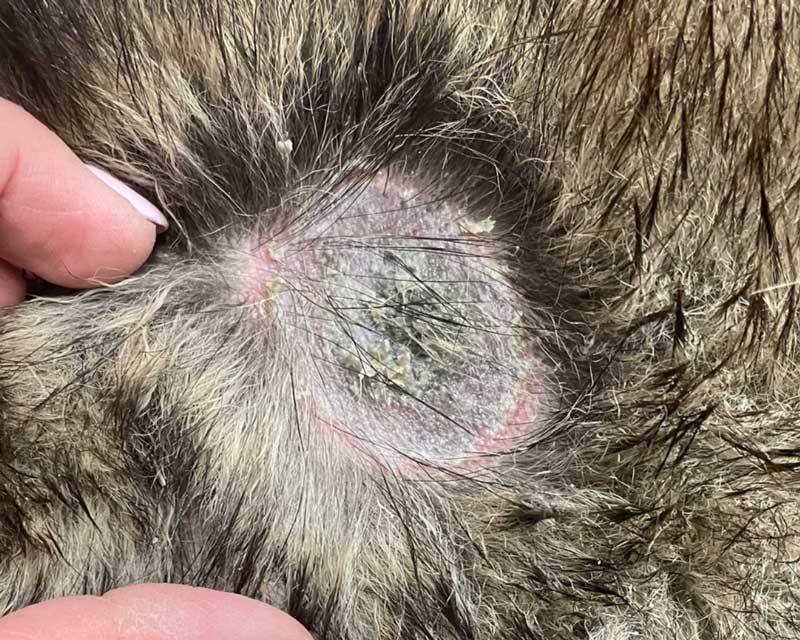
Ringworm
Not a nice ring to itAlso called dermatophytosis, ringworm is a fungus (nope, not a parasite) that consumes hair follicles and can spread to other animals and humans.
-
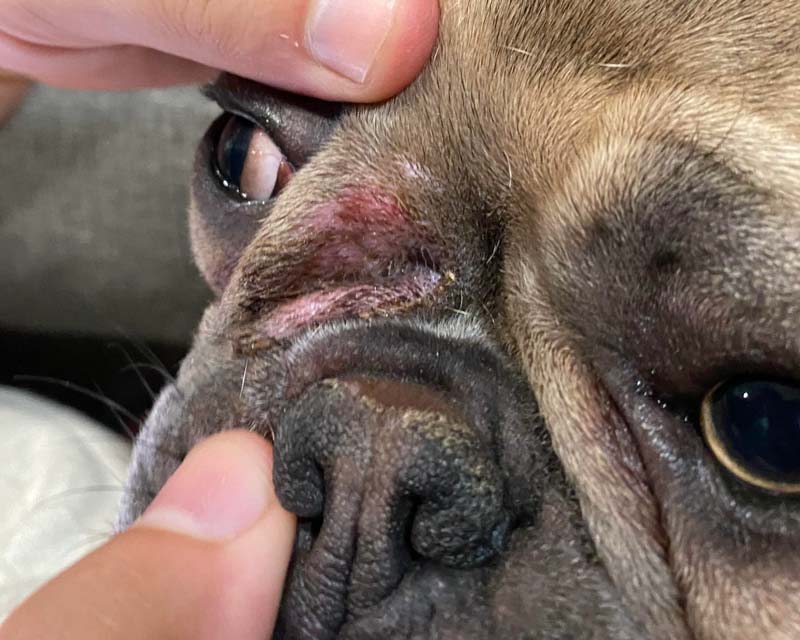
Skin Fold Dermatitis
Know when to foldFormally known as intertrigo, skin fold dermatitis plagues many dogs with wrinkles (i.e., bulldogs), sagging skin, or that are obese.
-
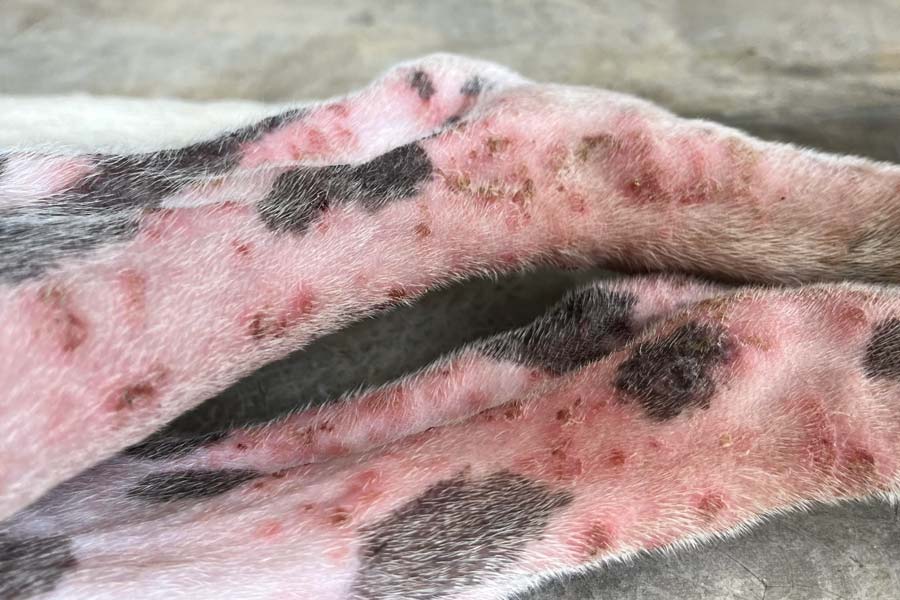
Pyoderma
Time for a Staph meetingThe formal name for a bacterial infection, pyoderma threatens every wound and itchy spot, and it can be very persistent and tough to kill.
Collapsible content
Resources on Malassezia + yeast infections in dogs
Canadian Veterinary Journal: Canine Malassezia Dermatitis
Bajwa J, 2017 Oct; 58(10): p. 1119-1121
Other Resources:
- VCA Animal Hospitals: Yeast Dermatitis in Dogs
- PetMD: Yeast Infections in Dogs
- American Kennel Club: Yeast Infections in Dogs: What You Need to Know
- Germantown Parkway Animal Hospital: Yeast Dermatitis in Dogs, Signs and Treatments
- Cornerstone Animal Clinic: Ear Infections
- Kingsdale Animal Hospital: Dog Paw Yeast Infections
- Newtown Veterinary Specialists: Yeast Dermatitis in Dogs: Causes, Symptoms, and Treatments


